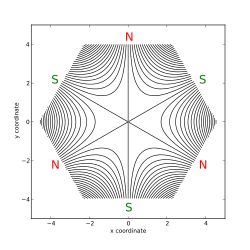17:
41:
200:) is dependent on the energy of the particle being focused—high energy particles having longer focal lengths than those with lower energy. Since all realistic beams have some, non-negligible, energy spread, any focusing scheme that relies purely on quadrupole magnets will result in the size of the beam "blowing up" with distance.
248:
In addition, the quadrature dependence of the sextupole kick on the transverse offset of the beam, can lead to high amplitude particles being kicked far from the beam axis and being lost on the beam-pipe walls. Due to this mechanism, the addition of sextupole fields to an accelerator lattice will
225:
Sextupolar fields have a focal length that is inversely proportional to the distance from the center of the magnet with which the particle passes. This is similar to the action of a quadrupole, whose effect on the beam may be described as a bending whose strength depends on the distance from the
180:
233:), then the sextupole can be set at a strength that ensures that particles of all reasonable energy offsets are focused to the same point. This will negate the tendency of the quadrupole lattice to disperse the beam.
241:
Sextupolar fields are non-linear (i.e. they depend on the product of the sizes of the transverse displacements), and have terms which depend on both the horizontal and vertical offsets (i.e. they are coupled).
245:
This leads to equations of motion that cannot be solved for the general case, thus requiring approximations to be used when calculating their effects on the beam.
95:
that flows in the coils of wire wrapped around the poles. The coils may be formed from hollow copper magnet wire that carry coolant, usually de-ionized water. The
127:
250:
56:) consist of six magnetic poles set out in an arrangement of alternating north and south poles arranged around an axis. They are used in
229:
If a sextupole is placed at a point at which the particles in the beam are arranged by their energy offset (i.e. a region of non-zero
16:
73:
341:
346:
196:
used to focus and combine the beam have the unfortunate property that their focusing strength (describable by a
40:
65:
25:
266:
57:
114:
77:
61:
29:
230:
204:
314:
117:, magnetic deflection is more powerful than electrostatic, and use of the magnetic term of the
291:
193:
99:
of such a conductor can be above 10 amps/mm (four times that of standard copper conductors).
286:
281:
92:
276:
186:
108:
96:
44:
Field lines of an idealized sextupole magnet in the plane transverse to the beam direction
254:
185:
is enabled with various magnets that make up 'the lattice' required to bend, steer and
335:
271:
118:
84:
222:
Typically this is controlled with the addition of sextupolar fields to the lattice.
215:
of the ring (the tendency for off-energy particles to have different values for the
212:
208:
197:
21:
175:{\displaystyle \mathbf {F} =q(\mathbf {E} +\mathbf {v} \times \mathbf {B} ),}
216:
33:
207:
this is due to the under- or over-focusing of the particles, while in
91:
pole tips of alternating polarity. The steel is magnetised by a large
69:
88:
39:
15:
130:
174:
317:. The European X-Ray Laser Project (XFEL). n.d
8:
20:Sextupole electromagnet as used within the
161:
153:
145:
131:
129:
303:
113:At the energies reached in high energy
309:
307:
7:
14:
74:transmission electron microscopes
162:
154:
146:
132:
83:The design of sextupoles using
166:
142:
1:
363:
219:phase advance per orbit).
106:
189:a charged particle beam.
103:In particle accelerators
68:. Two sets of sextupole
87:generally involves six
226:center of the magnet.
176:
45:
37:
26:Australian Synchrotron
267:Charged particle beam
211:it is related to the
177:
115:particle accelerators
66:head tail instability
62:chromatic aberrations
58:particle accelerators
43:
30:chromatic aberrations
19:
257:of the accelerator.
128:
78:spherical aberration
64:and for damping the
342:Accelerator physics
205:linear accelerators
60:for the control of
315:"Sextupole magnet"
194:quadrupole magnets
172:
46:
38:
292:Quadrupole magnet
52:(also known as a
354:
347:Types of magnets
326:
325:
323:
322:
311:
287:Multipole magnet
282:Halbach cylinder
251:dynamic aperture
181:
179:
178:
173:
165:
157:
149:
135:
93:electric current
50:sextupole magnet
362:
361:
357:
356:
355:
353:
352:
351:
332:
331:
330:
329:
320:
318:
313:
312:
305:
300:
277:Electron optics
263:
239:
126:
125:
111:
109:Strong focusing
105:
97:current density
76:to correct for
54:hexapole magnet
12:
11:
5:
360:
358:
350:
349:
344:
334:
333:
328:
327:
302:
301:
299:
296:
295:
294:
289:
284:
279:
274:
269:
262:
259:
238:
235:
183:
182:
171:
168:
164:
160:
156:
152:
148:
144:
141:
138:
134:
107:Main article:
104:
101:
85:electromagnets
13:
10:
9:
6:
4:
3:
2:
359:
348:
345:
343:
340:
339:
337:
316:
310:
308:
304:
297:
293:
290:
288:
285:
283:
280:
278:
275:
273:
272:Dipole magnet
270:
268:
265:
264:
260:
258:
256:
252:
246:
243:
236:
234:
232:
227:
223:
220:
218:
214:
210:
209:storage rings
206:
201:
199:
195:
190:
188:
169:
158:
150:
139:
136:
124:
123:
122:
120:
119:Lorentz force
116:
110:
102:
100:
98:
94:
90:
86:
81:
79:
75:
71:
67:
63:
59:
55:
51:
42:
35:
31:
27:
23:
18:
319:. Retrieved
247:
244:
240:
228:
224:
221:
213:chromaticity
202:
198:focal length
191:
184:
112:
82:
72:are used in
53:
49:
47:
22:storage ring
28:to correct
336:Categories
321:2008-09-17
298:References
255:acceptance
249:limit the
231:dispersion
159:×
261:See also
237:Problems
217:betatron
34:electron
70:magnets
32:of the
24:of the
187:focus
89:steel
192:The
36:beam
253:or
203:In
338::
306:^
121::
80:.
48:A
324:.
170:,
167:)
163:B
155:v
151:+
147:E
143:(
140:q
137:=
133:F
Text is available under the Creative Commons Attribution-ShareAlike License. Additional terms may apply.

